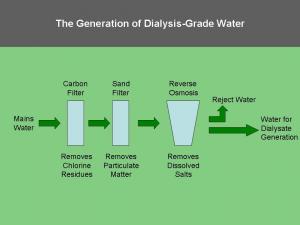- Group home
- You must register/login in order to post into this group.
Conserving Water in Haemodialysis - Case Study and How To Guide

By: East Kent Hospitals University NHS Foundation Trust
Considerable savings on mains water and sewerage costs, good for the environment as water is a finite natural resource, compliance with carbon targets
£7,500 (Actual)
Haemodialysis consumes vast quantities of water. Producing the 120 litres of dialysate required for a typical four hour session requires approximately 400 litres of mains water. Reverse osmosis is an important step in the purification process for water used in haemodialysis. Reverse osmosis systems reject up to two thirds of the water presented to them. This 'reject water' does not come into contact with the patient at any stage and poses no infection risk, yet it is 'lost to drain' in almost all dialysis facilities.
In 1999, two years after the Canterbury dialysis unit installed a new reverse osmosis plant, a simple system capable of recycling 800 litres of reject water per hour was installed at a cost of £15,000 with the help of the hospitals estate department. The system has now been running for over 10 years, saving the Trust £7,500 per year on mains water and sewerage costs.
The salvaged reject water is directed to a recovery tank in the basement. From there it is pumped up to the grey water tank on the roof, which then supplies the water to the hospital toilets. Float switches divert reject water to the drain if the grey water tank is full, and diverter valves direct the reject water directly to the drain from the reverse osmosis system during monthly chemical desinfections.
Investment Appraisal
The return on investment will depend upon:
1. The investment: the cost of installation & maintenance.
2. The return: the savings on mains water and waste water. This can be calculated by multiplying the regional mains water and waste water rates by the volume of reject water which the system is able to provide in place of mains water for an alternative use (e.g. laundry). It is useful to factor in projected price rises and changes in demand to gain a view of future potential savings.
Risk Management
Careful planning and calculations will prevent the implementation of a project which is financially inviable due to physical barriers or miscalculations regarding the amount of reject water produced.
The new use supplied by the recycled water needs a back-up mains supply.
Calculation of Carbon Savings
Carbon savings (kg CO2e/year)
=
[Volume water saved in one year (L) x mains water carbon conversion factor (kgCO2e/L)], e.g. DEFRA
-
[electricity used for pumping per year (kWh) x carbon conversion factor (kgCO2e/KWh)]
How To Guide - Getting started:
1. Discuss the idea with your Renal Technician. They will play a vital role in any water conservation project, understanding the local set-up better than anyone else.
2. Involve your local Estates department. The support and advice of the hospital Estates department is also vital. Their engagement may require the presentation of a sound business case. In most cases, it will be the Estates department that benefit financially from the methodology.
3. Clarify the scenario. Will the methodology be implemented into the design of a ‘new build’ dialysis unit, at the time of replacing the RO system in an existing dialysis unit, or perhaps alongside an existing and satisfactory RO system already in place in a dialysis unit? These different scenarios will influence the total costs involved, but the return on investment may still make the project worthwhile.
4. Clarify the potential volume of reject water that will be salvaged each year.
In order to maximise the financial and environmental benefits of the project, it is important to match the volume of reject water available to an alternative use that requires a similar volume. Many reverse osmosis systems record the volume of reject water produced, but this can be ascertained with a simple flow meter if necessary. It should be remembered that, where reverse osmosis systems are being replaced, the newer system is likely to be more efficient and produce less reject water.
5. Assess the quality of the reject water to be salvaged. The precise quality of the reject water produced will vary from region to region. Whilst it will almost always meet the requirements for its intended use, it is vital that this is assured prior to proceeding further. Your renal technician will be well versed in checking the water quality.
6. Given the volume and quality of the reject water available, now identify the intended use for this water. Possibilities include: sanitation, laundry, boiler feed, sterilisation units and irrigation – on site or supplied to a neighbouring facility. Practical considerations are important. For example, salvaged reject water can only be used in laundry services if the plumbing required is feasible and affordable.
7. Calculate the financial cost per year of the current practice of supplying mains water for this intended use. This will require knowledge of the mains water rates for your hospital, information which the Estates department can provide.
8. Calculate the financial savings resulting from the reduction in waste water from the haemodialysis unit. This will require knowledge of the waste-water rates for your hospital. Remember that some reject water may still be lost to drain if it exceeds the demand/capacity of the salvage system, and during disinfection cycles.
9. Calculate the initial total financial expenditure incurred in implementing the methodology (including the infrastructure required to transport the reject water to the place of use). Costs may include: storage tanks, pipework, pumps and installation costs. Maintenance costs are likely to be small.
10. From these figures, develop a repayment projection and calculate the breakeven point (the point in time by which the savings - due to reduced mains water and reduced losses-to-drain - might be anticipated to have recouped the investment costs of the methodology, and from whence the use of reject water for the new purpose realises potential savings).
11. Convince your Trust to fund the work. Whilst this will certainly require the support of your Estates department, it may also require the approval of the Director of Finance. It is also worth applying for funding from Salix Finance, an organisation set up by the Carbon Trust to deliver interest free funding to accelerate investment in energy efficiency technologies within the UK public sector. Their website is http://www.salixfinance.co.uk/home.html
12. System maintenance should become part of routine estates plant room inspections - a simple check function tick list is sufficient. Water storage tanks will require cleaning in line with Trust protocols for other tanks in the hospital.
Canterbury dialysis unit and satellite dialysis unit in Ashford
Large volumes of 'reject' water were lost to the drains
Hospital's estate department
